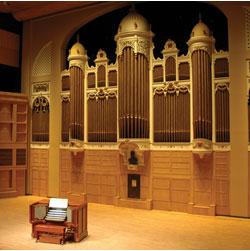
Friends of the Kotzschmar Organ (FOKO) announce they will move forward with renovating the nearly century-old pipe organ with support from the City of Portland.
The Portland City Council voted unanimously in favor of a $1.5 million bond of which $1.25 million will be designated to fund renovations and repair of the organ, which is owned by the city, but maintained by the nonprofit group.
City officials plan to pay back the bond by extending the $2 surcharge on tickets sold for events at Merrill Auditorium. Kathleen Grammer, executive director of FOKO, said the group will match the city’s contribution with private donations secured through a larger fundraising campaign focused on ensuring the organ’s sustainability into the future.
Foley-Baker, Inc. of Tolland, Connecticut, which specializes in pipe organ repair and reconditioning, will complete the Kotzschmar’s renovation during an estimated 18-month period. Foley-Baker has completed major reconditioning on the organs at Boston’s Symphony Hall, Duke University, and the First Church of Christ, Scientist, the Mother Church in Boston, among others.
“The Kotzschmar Organ is a rare civic treasure that has been part of life in Portland for nearly a century,” stated John Bishop, who serves as Chair of the FOKO Organ Committee. “It has survived a century of use, relocation, and the renovation of Merrill Auditorium while continually thrilling audiences and concert artists. There can be no better way to celebrate this centennial than treating this magnificent instrument to a complete and professional renovation in preparation for another century of thrilling music. The Organ Committee of the Friends of the Kotzschmar Organ is thrilled to participate in this historic project, and we applaud the City of Portland for its deep support of this great instrument. We are delighted to be working with the people of Foley-Baker, Inc. in Tolland, Connecticut—a firm with an impressive dossier of projects renovating some of the greatest organs in the United States. We know that their dedication and skill will make the Kotzschmar Organ shine like new.”
The Kotzschmar Organ is scheduled to leave Merrill Auditorium in September 2012 for Foley-Baker, with an expected return in 2014. In the meantime, the music of the Kotzschmar will begin a different sort of journey. Ray Cornils, who has served as Portland’s municipal organist for more than two decades, will take the concerts on the road, traveling throughout Maine and New England for performances. Those specific dates and venues are currently in the planning process.
The Kotzschmar Organ was a gift to the City of Portland by publishing magnate Cyrus Curtis. It is named in memory of Hermann Kotzschmar, a German musician, who lived in Portland from 1849 until his death in 1908. He is remembered for leading the city in its musical awakening and development.
For information: www.foko.org.


